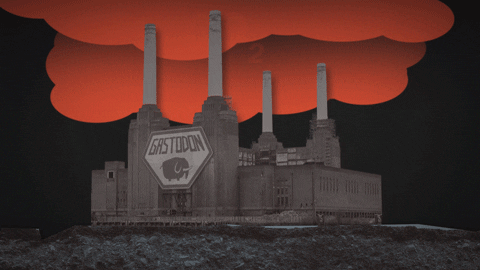Sponge Cities 🧽
An urban development model to help cities absorb, store, and reuse excess water from floods and rainfall.
Welcome to a new episode of Year 2049, your weekly guide to the events, discoveries, and innovations shaping the future of tech, climate, science, and more.
If this was forwarded to you, subscribe to get a new story in your inbox every Friday 👇
Happy Friday!
Summer is technically over and I hope you got your fair share of awkward tan lines like I did. I want to personally thank aloe vera gel for making me look less ridiculous.

Did you notice the weather being hotter than usual when you were spending time at the park or beach over the past few months? If you’re nodding your head, you were certainly right: July 2021 was officially Earth’s hottest month on record (per NOAA).
So, let’s talk about something we can’t ignore anymore: climate change.
Time to read ~ 4-6 minutes
At your own risk
Follow Year 2049: Instagram | Twitter | LinkedIn
If this was forwarded to you, make sure to subscribe to get my comics and stories in your inbox every Friday.
The backstory
A worrying report from the IPCC
Last month, the Intergovernmental Panel on Climate Change (IPCC) published a 4000-page report about the current and future state of the climate. It’s no surprise that their findings were bad. If you live in California, British Columbia, or Greece, you’ve seen the effects of it with the devastating wildfires around you this year. Even if you don’t live in these places, you’ve probably noticed the weather “acting weird”. Some worrying numbers about where we are today:
Global temperatures are at their highest in 125,000 years
The concentration of carbon dioxide in the air is at its highest in 2 million years
Greenhouse gas emissions are rising faster than any time in the last 800,000 years
The Paris Agreement
Climatologists have been warning us for decades about this, with little to no reaction from people and governments. In recent years, the world has become increasingly more aware of our impact on the climate due to advances in climatology and data collection. 190 countries have formally signed the Paris Agreement, a legally binding treaty to limit global warming to well below 2ºC (preferably 1.5ºC) compared to pre-industrial times.
We’ve already increased global temperatures by 1.1ºC since the first Industrial Revolution.
Our impact on the climate

Humans didn’t have a significant impact on the climate until the first Industrial Revolution in the 1700s. That was when we started using machines and new sources of energy to mass-produce goods of all kinds. The industrialization process wouldn't have been possible without the energy we extract from fossil fuels such as coal, natural gas, and oil. The burning of fossil fuels releases large amounts of CO2 and other greenhouse gases into the air, which means more heat is being trapped in the atmosphere causing global temperatures to increase.
It’s tremendous irony that the very substances that helped us achieve this level of development today are now the very substances that endanger the future of civilization as we know it.
– Katharine Hayhoe
Professor Yu to the rescue
Professor Kongjian Yu is a landscape architecture graduate from Harvard University. After completing his studies, he returned to China to find a way to protect cities from floods. He created the “sponge city” concept, an urban planning model to help cities absorb, store, and reuse excess water from floods and rainfall. This concept is currently being adopted by multiple cities in China, and other countries including Indonesia, Russia, and the US.
How “sponge cities” work 🧽
The typical approach to “fighting” excess water is to shield ourselves from it by building seawalls and barriers. Professor Yu proposes the exact opposite: cities should be absorbing, cleaning, and reusing all that excess water. This requires replacing “grey infrastructure” such as concrete sidewalks and seawalls with “green infrastructure” including:
Permeable sidewalks and roads
Concrete sidewalks are terrible at absorbing water. Replacing them with more permeable material allows the water to filter through the ground to be stored and reused.

Green roofs and walls
Covering roofs and walls with plants effectively absorbs excess water and slowly releases it through evaporation and photosynthesis. This solution can also reduce building energy usage, noise levels, and increase the durability and lifespan of roofs, according to the US Environmental Protection Agency. Green roofs and walls are helpful for extreme rainfall and not floods, but they’re still worth mentioning.
They also look reaaaaaaally nice.

Interconnected waterways
We should “give water space”, says Professor Yu. By creating waterways and terraces to allow water to move freely between neighbourhoods, we can avoid damage from rising sea levels and create green spaces and parks for all of us to enjoy. It can also help restore marine species and ecosystems and give them a favourable environment to breed.

Final thoughts
Yu’s “sponge city” concept sounds very promising compared to other solutions I’ve read about such as creating seawalls across coasts or raising roads, which seem like short-term solutions that don’t address the core issues of climate change. Will we keep building higher walls to keep ourselves safe from floods? Probably not. The climate is inevitably changing and our cities need long-term solutions that adapt to it. And with increasing energy demands every year, the need for cleaner energy alternatives has never been higher. This requires significant investments today to avoid an even bigger price to pay in the future.
Scientists, marine biologists, politicians (not all of them, lol), and others around the world are dedicating their lives to tackle climate change just like Professor Yu. These are the people we need to enable and empower whether it’s through funding, volunteering, or simply raising awareness about their work. Expect more stories about climate change solutions while you’re subscribed to Year 2049.
What do you think of sponge cities? Leave a comment and I’ll share any interesting responses I get next week.
A big thank you to my friends Natalie and Seif who gave me great suggestions on how to improve this story.
Deep dive
If you liked this week’s comic and story and want to learn more, here are some links to satisfy your curiosity:
A fantastic summary of the IPCC’s report (Quartz)
Evolution of annual CO2 emissions from coal, gas, and oil since 1750 (Our World in Data)
Paris Climate Agreement: Everything You Need to Know (NRDC)
What sea level rise will do to coastal cities (Verge Science/YouTube)
Professor Yu talks about sponge cities (World Economic Forum/YouTube)
If you missed the previous episode
Next week
I hope you enjoyed today’s comic and story! Next week, I’ll be talking about an algorithm that could revolutionize food production as we know it.
Make sure you’re subscribed so you don’t miss it 👇
or follow Year 2049 on Instagram, Twitter, or LinkedIn.
Much love,
Fawzi












I love sponge cities as a concept, not sure about the real world viability. Trees, plants and the like love to spread their roots and disrupt walls and the like.
It would take incredibly.skilled gardneers to keep a sponge city in working order.
Love this articles, i like how you dive into an international analysis on it and provide explanations. Looking forward to more!